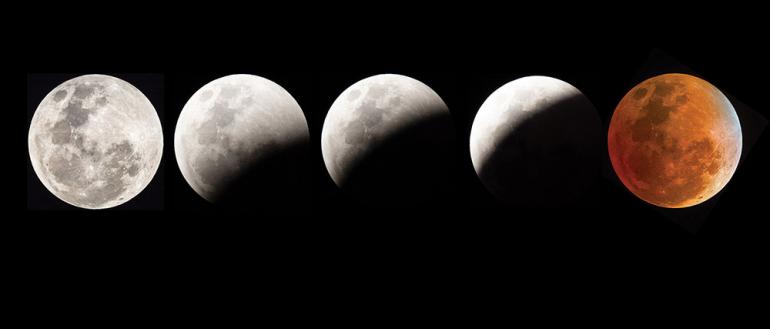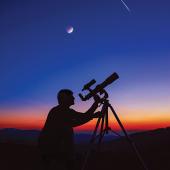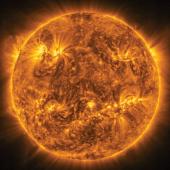Fall's lunar lightshow.
In the sky, what goes around usually comes around, in a manner of speaking. If you missed the moon’s pre-dawn tussle with the Earth’s shadow last May, you’ve got another chance to witness this cosmic dust-up on the night of November 18, when the going-around moon comes around to blunder into our shadow once again.
Last May, the moon passed barely inside the northern part of the dark inner shadow, called the umbra, to produce a 15-minute total eclipse. This time, it passes through the southern part, but doesn’t quite make it all the way in; a tiny slice stays outside in the brighter outer part of the shadow called the penumbra. This will technically be a partial eclipse, but the visual effect will be about the same as in May: a red-orange moon with a bright white rind, this time on the bottom. It will give the moon a Chinese-lantern look.
For the November eclipse you have to stay up late, but the moon is much better placed than it was last spring. Begin the night by going out after sunset on the evening of the 18th and look west; you’ll see a string of planets low in the southwestern sunset sky. Brilliant Venus is unmistakable as it will be closest to the horizon; bright Jupiter will be up and to the left of it. Saturn, the dimmest of the three, will be down and to the right of Jupiter.
Once oriented, turn around to watch the full Beaver Moon of November rise in the east. It’s so-named in North American folklore because this is the time when beavers have prepared their lodges for winter—and your lodge had best be prepared, too.
As the night passes, the moon will rise high into the southern sky. About 11pm MST, the orbiting moon will hit the penumbra of the Earth’s shadow, but you won’t notice. A little after midnight, around 12:19am on the morning of November 19, the moon will reach the umbra—and that you will notice. The fuzzy-edged, curved darkness will begin to gobble up the moon, which will turn red-orange, especially on the upper portion which bores deepest into the shadow.
Greatest eclipse comes around 2:03am, when the lovely lantern effect will be at its best: the Man-in-the-Moon’s chin will be bright white, his face shading from pale orange to darker red-orange up to his forehead.
Earlier peoples did not see this as a good look for the moon. They assumed some fierce creature was on the attack. In northern California, some Native Americans saw the moon as a hunter with many fierce pets like mountain lions and rattlesnakes; when they didn’t like what he brought them home to eat, they tried to eat him instead, and the moon went bloody. It was then up to the hunter’s wives to pick up the pieces and nurse him back to health.
After greatest eclipse, the moon begins to recover on its own as it slips out of the umbra, clearing it around 3:47am MST, and finally the much fainter penumbra just after 5am.
Whether a Chinese dragon, an Incan jaguar, a Norse wolf, or dissatisfied “pets,” mythically there always seem to be animals involved. This November, it will actually be Taurus the bull, in which the moon sits during the eclipse—just right of the V-shaped pattern that marks the constellation’s head, and below the little Pleiades star cluster, which marks his shoulder. That puts the moon squarely in the bull’s stomach, as if he decided to make of it a midnight snack.
You might take a few snacks with you out into the cold November night, and if it’s clear out, watch the bull try to digest his. The Chinese lantern moon hanging below the Pleiades will be a sight well worth staying up for.
Jim Manning is the former executive director of the Astronomical Society of the Pacific. He lives in Bozeman.





